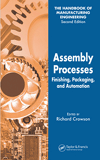Automation Profiles: System Assembles Nuclear Implants for Life-Saving Cancer Therapy
Assembly stations are located in a sealed box filled with 100 percent argon.
 Cancer treatment has advanced immeasurably over the past decade. One recent breakthrough is nuclear implants. These tiny devices enable oncologists to deliver tumor-destroying radiation therapy to precise locations in the body. This spares healthy tissues and reduces debilitating side effects.
Cancer treatment has advanced immeasurably over the past decade. One recent breakthrough is nuclear implants. These tiny devices enable oncologists to deliver tumor-destroying radiation therapy to precise locations in the body. This spares healthy tissues and reduces debilitating side effects.
One such implant is produced on a high-speed automated assembly system designed by Ixmation Cox Systems. The assembly consists of a radioactive copper wire inserted into a titanium tube. Titanium end caps are hermetically welded onto the ends of the tube. The outside diameter of the tube is 0.032 inch, and the length is 0.176 inch. The system assembles one part every 5 seconds.
In this profile, John O’Hara, director of applications engineering at Ixmation, describes the system. For more information, call Ixmation at 630-351-3000 or visit www.ixmation.us.
The system is located in a completely sealed box filled with a 100 percent argon atmosphere. Due to the radioactive nature of the product, all maintenance and operation of the machine must be done through gloves that are built into the box. Because operators can only access the machinery through the glove ports, we designed the system to be as compact as possible. This also minimized the amount of argon needed to fill the box. In addition, we had to specify machine components that would hold up in a radioactive environment.
The system is based on a rotary dial. Tubes and end caps are fed from vibratory feeders, while the copper wire is presented from a tube. All feed and load operations incorporate closed-loop positioning based on input from machine vision systems.
The tubes are loaded into a fixture that clamps on their outside diameter. The center line of the tube is vertical. The inside of the tube is then inspected with a borescope to ensure its integrity. Keep in mind that the inside diameter of the tube is 0.018 inch.
An end cap is placed onto the top of the tube using linear stages. The placement accuracy of this positioning operation is ±0.002 inch. Upon final positioning of the end cap, an Nd:YAG laser tack-welds it into place. It then completes the weld with a 360-degree seam. The part is stationary, while the laser energy is directed to the seam through rotating optics.
Next, the assembly is flipped over, and the copper wire is inserted into the tube using linear stages. Following the insertion, the assembly is inspected to ensure that the wire is present and fully inserted.
The second end cap is placed onto the top of the tube using linear stages. Like the first end cap, the second is placed with an accuracy of ±0.002 inch. Once the end cap is in place, the laser tack-welds it in place, then finishes the weld with a 360-degree seam. This operation completes the assembly, producing a hermetically sealed container for the radioactive copper wire.
The part is then subjected to a number of high-magnification and high-resolution machine vision inspections. If it passes, the part is off-loaded from the machine into a tray for subsequent processing.
Editor’s note: Whether you’re a systems integrator or the in-house automation team of an OEM, if you’ve designed a system that you’re particularly proud of, tell us about it. Send an e-mail to John Sprovieri, editor of ASSEMBLY, at sprovierij@bnpmedia.com, or call 630-694-4012.

One such implant is produced on a high-speed automated assembly system designed by Ixmation Cox Systems. The assembly consists of a radioactive copper wire inserted into a titanium tube. Titanium end caps are hermetically welded onto the ends of the tube. The outside diameter of the tube is 0.032 inch, and the length is 0.176 inch. The system assembles one part every 5 seconds.
In this profile, John O’Hara, director of applications engineering at Ixmation, describes the system. For more information, call Ixmation at 630-351-3000 or visit www.ixmation.us.
The system is located in a completely sealed box filled with a 100 percent argon atmosphere. Due to the radioactive nature of the product, all maintenance and operation of the machine must be done through gloves that are built into the box. Because operators can only access the machinery through the glove ports, we designed the system to be as compact as possible. This also minimized the amount of argon needed to fill the box. In addition, we had to specify machine components that would hold up in a radioactive environment.
The system is based on a rotary dial. Tubes and end caps are fed from vibratory feeders, while the copper wire is presented from a tube. All feed and load operations incorporate closed-loop positioning based on input from machine vision systems.
The tubes are loaded into a fixture that clamps on their outside diameter. The center line of the tube is vertical. The inside of the tube is then inspected with a borescope to ensure its integrity. Keep in mind that the inside diameter of the tube is 0.018 inch.
An end cap is placed onto the top of the tube using linear stages. The placement accuracy of this positioning operation is ±0.002 inch. Upon final positioning of the end cap, an Nd:YAG laser tack-welds it into place. It then completes the weld with a 360-degree seam. The part is stationary, while the laser energy is directed to the seam through rotating optics.
Next, the assembly is flipped over, and the copper wire is inserted into the tube using linear stages. Following the insertion, the assembly is inspected to ensure that the wire is present and fully inserted.
The second end cap is placed onto the top of the tube using linear stages. Like the first end cap, the second is placed with an accuracy of ±0.002 inch. Once the end cap is in place, the laser tack-welds it in place, then finishes the weld with a 360-degree seam. This operation completes the assembly, producing a hermetically sealed container for the radioactive copper wire.
The part is then subjected to a number of high-magnification and high-resolution machine vision inspections. If it passes, the part is off-loaded from the machine into a tray for subsequent processing.
Editor’s note: Whether you’re a systems integrator or the in-house automation team of an OEM, if you’ve designed a system that you’re particularly proud of, tell us about it. Send an e-mail to John Sprovieri, editor of ASSEMBLY, at sprovierij@bnpmedia.com, or call 630-694-4012.
Looking for a reprint of this article?
From high-res PDFs to custom plaques, order your copy today!






